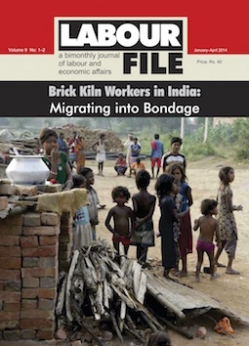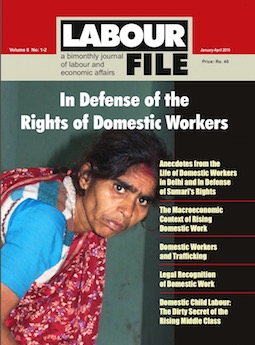Social Security and the Legislative Fraud
Babu Mathew is Professor of Law and Faculty Coordinator for Law and Society Cluster at the National Law School of India University, Bangalore. Rashmi Shetty is a Visiting Lecturer at the University.. (Babu Mathew & Rashmi Shetty)
Ever since the Industrial Revolution and especially during the last century, a great deal of attention was focused on the working class who belong to the formal sector. There were many factors, which contributed to this. Above all, societies where classical transformation took place were societies in which all earlier modes of production were almost totally wiped out and yielded to the capitalist form. As a result, the working class constituted a substantive part of the population and paying attention to this class made sense.
Against this background the Russian Revolution created a new fear in the minds of the ruling classes especially in
Focus on Formal Sector
The recognition of collective bargaining and enactment of legislation to give effect to ILO Conventions and the creation of a welfare State facilitated the “golden age of capitalism.” Workers got a reasonable share of profit as wages, which gave them purchasing capacity, generated new demand and enabled the production of more and more commodities, which in turn sustained capitalism.
In addition, development economists subscribed to the view that movement of all working people would naturally be from the primary sector to the secondary sector and then to the tertiary sector. Even socialist economists accepted this paradigm. Planned economic development was itself based on this model.
The Mask Lifts
It is only during the past few decades that the illusion behind this paradigm began to reveal itself. The collapse of the socialist model accentuated the crisis especially because neo-liberalism was left without any global challenge whatsoever. We have now reached a stage in which the illusion of full employment is fast receding and theorists of the neo- liberal order are trying to reconceptualise the problems of unemployment by creating fresh illusions. One such new illusion relates to the growth of the informal sector as if such growth was a positive outcome of the neo-liberal path. In reality this expansion of the informal sector reflects the accentuation of the agrarian crisis, pauperisation, marginalisation and migration from one centre to another, from the rural to the urban and back again to the villages, all in desperate search of livelihood options. When we talk about the informal sector or the unorganised sector and the effort to provide social security to them we are therefore dealing with this aspect of the prevailing political economy.
Concern for Informal Sector?
Neo-liberalism now considers it safe to take back all the concessions that were once given to the working people during the previous century, for reasons already mentioned above. At the same time there is a fig leaf of concern for the informal sector and this is globally manifested through the instrumentality of the ILO in their proclamation of core labour standards. In this context it is significant to note that during the World Summit for Social Development at
The Indian government, having accepted the neo-liberal paradigm partakes in an identical process whereby flexibility is prescribed for the formal sector and protection is talked about for the informal sector. The Second National Commission for Labour was asked to deliver such a package and it provided a discourse to supplement the government’s thinking and pretended to offer relief through an indicative bill which itself was an apology for the recommendations it made and flawed in many ways.
The government, however, decided to be even more Machiavellian, it pretended to undertake the drafting of an even more comprehensive social security legislation. One draft after another was produced until we reached the stage of the fourth draft, which incidentally coincided with the end of the political term of the ruling party. Yet there was a pretension of this bill being considered and finally even that was put on hold.
Flawed Legislation
A brief examination of the fourth draft of the social security legislation would, therefore, be in order so that we can decipher the nature and the extent of legislative fraud that is now dished out in the form of the bill drafted on behalf of the central government. Chapter I follows the Anglo-Saxon method of defining one word after another in such a manner that an ordinary person could hardly quarrel about it not knowing that all of them add up to nothing. The second chapter carries the deception even further. It solemnly creates the central board, the state board and the workers facilitation centre. If ever the bill becomes a law it is indeed this chapter that will be brought into force in order to dish out political patronage and distribute money collected form workers and industries in a manner in which such parasitic paraphernalia would be quite happy. We then come to the core of the legislation. It pretends to offer social security benefits and welfare measures. It liberally spells out what kind of schemes may be created but adds the operative words “subject to the sustainability of the fund.” We must, therefore, move on to Chapter IV, which deals with the “Fund.” Suddenly the central government remembers that labour comes in the concurrent list and therefore transfers the responsibility to the appropriate government. In other words if the bulk of the informal sector has to be covered then it will be the state governments’ burden to raise the resources when all other identified contributions prove to be inadequate. There is provision for a cess or a tax or a fee, which again is left to the will of the appropriate government and thus we are forced to come to the conclusion that the legislation is ornamental verbiage intended to throw dust in the eyes of workers in the informal sector.
For all these reasons and more the National Centre for Labour, which examined these processes carried out by the central government, called the exercise a “sham” and rejected the effort lock, stock and barrel. Meanwhile, the central government went back even on this fourth draft and finally concluded by proposing a pension scheme to be introduced on a trial basis in 50 selected constituencies on the eve of the general elections.
Model Laws Already Exist
It is not as if we do not have within the country the necessary expertise to draft a more efficacious legislation. The model contained in the Port and Dock Workers Act of 1948 and adopted almost verbatim by the Maharatra Mathadi, Hamal and other Manual workers Act of 1969 are models, which can deliver results. The construction workers of
The message is, therefore, clear that there is no political will to come to the rescue of the informal sector. It is well known that there are 370 million in this workforce. The budgetary allocation for them until now has been less than 1 per cent of the Gross Domestic Product (GDP), in stark contrast to the allocation in
The time has come to expose this legislative fraud and call upon the workers and their unions in the informal sector to make their voices heard.
Title of the Article: Social Security and the Legislative Fraud
Name of the Journal: Labour File
Volume & Issue: 2 , 1
Year of Publication: 2004
Month of Publication: January - February
Page numbers in Printed version: Labour File, Vol.2-No.1, Labour in 2003 (Article - Social Security and the Legislative Fraud - pp 30-34)
Weblink : https://labourfile.com:443/section-detail.php?aid=67




.jpg)
.jpg)


